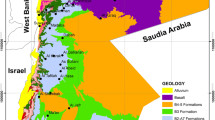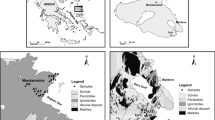Abstract
Recently, occurrences of elevated arsenic concentrations in bedrock groundwaters used for individual and municipal water supplies have been recognised along the mainland coast of southern British Columbia, Canada. An area on Bowen Island (Queen Charlotte Heights community) was chosen to investigate the source(s) of arsenic, geochemical processes controlling its aqueous uptake, the role of geology and structure in the formation of these waters, and the use of hydrogeochemical survey methods for detecting arsenious groundwater regions. Pyrite- arsenopyrite-Cu mineralisation in the Queen Charlotte Heights area is present as veins associated with NE-trending fault zones and as disseminations in marginal breccia and stockwork zones of a ryhodacite porphyry stock. Near surface mineralisation was later altered by supergene events to form minor pyrite- arsenopyrite in a matrix of limonite and clay. Geochemical factors that control the concentration and mobility of arsenic in these groundwaters include: (a) anion exchange of arsenic from clay minerals during cation divalent/univalent exchange processes (water softening) which leads to waters of high pH and high anion exchange capacities; (b) desorption of arsenic from Fe and Al oxyhydroxide minerals during pronounced shifts in pH from acid to alkaline conditions brought on by the water softening process; and (c) stepwise oxidation of arsenopyrite mineralisation to form arsenious sulphate-bearing groundwaters. The inconsistent behaviour of the As3+ and As5+ ions during the complex waterrock interaction processes described above, precludes the use of detailed chemical analyses to predict relative abundances of the more toxic As3+ species. For a full appreciation of the toxic impact of groundwaters containing total arsenic concentrations that are above regulatory guidelines an arsenic speciation analysis is required.
Similar content being viewed by others
References
Anderson, R.K., Thompson, M. and Culbard, E. 1986a. Selective reduction of arsenic species by continuous hydride generation Part I. Reaction media. Analyst, 111, 1143–1152.
Anderson, R.K., Thompson, M. and Culbard, E. 1986b. Selective reduction of arsenic species by continuous hydride generation Part II. Validation of methods for application to natural waters. Analyst, 111, 1153–1158.
Anonymous 1923. Bowena Copper Mine. Mining and Engineering Record, 27, (3–4), 34–35.
Bottomley, D.J. 1984. Origins of some arseniferous groundwaters in Nova Scotia and New Brunswick, Canada. Journal of Hydrology. 69, 223–257.
Boyle, D.R. 1992. Effects of base exchange softening of fluoride uptake in groundwaters of the Moncton Sub-Basin, New Brunswick, Canada. In: Y.K. Kharaka and A.S. Maest (eds), Proceedings of the 7th International Symposium on Water-Rock Interaction, Park City, Utah, pp. 771–774, A.A. Balkema, Rotterdam.
Boyle, R.W. and Jonasson, I.R. 1973. The geochemistry of arsenic and its use as an indicator element in geochemical prospecting. Journal of Geochemical Exploration, 2, 108–123.
Bright, D.A. 1989. Electrode response to the As(V)/As(III) redox couple and the use of arsenic speciation as an indicator of redox conditions in natural water systems. MSc Thesis, University of Colorado.
Carmichael, V. 1995. Well Water Survey for Arsenic in the Powell River and Sunshine Coast Communities of British Columbia. Environmental Health Assessment Unit, Environmental Health Assessment and Safety Branch, British Columbia Ministry of Health, Victoria, BC, USA.
Chatterjee, A., Das, D., Mandal, B.K., Chowdhury, T.R., Samanta, G. and Chakraborti, D. 1995. Arsenic in ground water in six districts of West Bengal, India: the biggest arsenic calamity in the world. Part 1. Arsenic species in drinking water and urine of the affected people. Analyst, 120, 643–650.
Cherry, J.A., Shaikh, A.U., Tallman, D.E. and Nicholson, R.V. 1979. Arsenic species as an indicator of redox conditions in groundwater. Journal of Hydrology, 43, 373–392.
Clague, J.J. 1994. Quaternary stratigraphy and history of south-coastal British Columbia. In: J.W.H. Monger (ed.), Geology and Geological Hazards of the Vancouver Region, Southwestern British Columbia. Geological Survey of Canada Bulletin 481, 181–192.
Cullen, W.R. and Reimer, K. J. 1989. Arsenic speciation in the environment. Chemical Reviews, 89, 713–764.
Das, D., Chatterjee, A., Mandal, B.K., Samanta, G. and Chakraborti, D. 1995. Arsenic in ground water in six districts of West Bengal, India: the biggest arsenic calamity in the world. Part 2. Arsenic concentration in drinking water, hair, nails, urine, skin-scale, and liver tissue (biopsy) of the affected people. Analyst, 120, 917–924.
Ferguson, J.F. and Gavis, J. 1971. A review of the arsenic cycle in natural waters. Water Research, 6, 1259–1274.
Ferguson, J.F. and Anderson, M.A. 1974. Chemical forms of arsenic in water supplies and their removal. In: A.J. Rubin (ed.), Chemistry of Water Supply, Treatment, and Distribution, Chapter 7, pp. 137–158. Ann Arbor Science Publ.
Fowler, B.A., Ishinishi, N., Tsuchiya, K. and Vahter, M. 1979. Arsenic. In: L. Friberg, G.F. Nordbert and V. Vouk (eds.), Handbook on the Toxicology of Metals, pp. 293–319. Elsevier Science Publishers, Amsterdam, The Netherlands.
Friedman, R.M., Monger, J.W.H. and Tipper, H.W. 1990. Age of the Bowen Island Group, southwestern Coast Mountains, British Columbia. Canadian Journal of Earth Sciences, 27, 1456–1461.
Frost, R.R. and Griffin, R.A. 1977. Effect of pH on adsorption of arsenic and selenium from landfill leachate by clay minerals. Soil Science Society of America Journal, 41, 53–56.
Government of Canada 1994. Arsenic and its Compounds. Canadian Environmental Protection Act, Priority Substances List Assessment Report, Ottawa.
Grantham, D.A. and Jones, J.F. 1977. Arsenic contamination of water wells in Nova Scotia. Journal of the American Water Works Association, 69, 653–657.
Gulens, J., Champ, D.R. and Jackson, R.E. 1979. Influence of redox environments on the mobility of arsenic in ground water. In: E. A. Jenne (ed.) Chemical modeling in aqueous systems; speciation, sorption, solubility, and kinetics. American Chemical Society Symposium Series, 93, 81–95.
Gupta, S.K. and Chen, K.Y. 1978. Arsenic removal by adsorption. Journal of the Water Pollution Control Federation, 50, 493–506.
Holm, T.R., Anderson, M.A., Iverson, D.G. and Stanforth, R.S. 1979. Heterogeneous interactions of arsenic in aquatic systems. In: E. A. Jenne (ed.), Chemical modeling in aqueous systems; speciation, sorption, solubility, and kinetics. American Chemical Society Symposium Series, 93, 711–736.
Korte, N. 1991. Naturally occurring arsenic in groundwaters of the Midwestern United States. Environmental Geology and Water Sciences, 18, 137–141.
Matisoff, G., Khourey, C.J., Hall, J.F., Varnes, A.W. and Strain, W.H. 1982. The nature and source of arsenic in northeastern Ohio ground water. Ground Water, 20, 446–456.
Meranger, J.C., Subramanian, K.S. and McCurdy, R.F. 1984. Arsenic in Nova Scotian groundwater. Science of the Total Environment, 39, 49–55.
Mertz, W. 1981, The essential trace elements. Science, 213, 1332–1338.
Monger, J.W.H. and Journeay, J.M. 1994. Guide to the geology and tectonic evolution of the southern Coast Mountains. Geological Survey of Canada Open File 2490, 77p.
Percival, J.B., Dumaresq, C.G., Kwong, Y.T.J., Hendry, K.B. and Michel, F.A. 1996. Arsenic in surface waters, Cobalt, Ontario. Geological Survey of Canada Paper 96-C, 137–146.
Peters, L.P. 1977. Summary of the Occurrence of Arsenic and Selected Heavy Metals in Rural Domestic Water Supplies in the York and Charlotte Counties of the Province of New Brunswick, Canada. New Brunswick Department of Environment Water Resources Branch Publication No. T7709, pp. 1–27, Fredericton, New Brunswick, USA.
Pierce, M. and Moore, C.B. 1982. Adsorption of arsenite and arsenate on amorphous iron hydroxide. Water Research, 16, 1247–1253.
Pojar, J., Klinka, K. and Meidinger, D.V. 1987. Biogeoclimatic ecosystem classification in British Columbia. Forest Ecology Management, 22, 119–154.
Reitzel, N.M. 1984. Arsenic in rock wells in central Massachusetts. In: T.C. Crusberg, R.D. Cheetham, and A.H. Hoffman, (eds.), Water Quality and the Public Health; Proceedings of a Conference, pp. 116–126. Worcester Polytechnic Institute, Worcester, MA.
Robertson, F.N. 1986. Occurrence and solubility controls of trace elements in ground water in alluvial basins of Arizona. United States Geological Survey, Water Resources Monograph Series, 7, 69–80.
Robertson, F.N. 1989. Arsenic in ground-water under oxidizing conditions, South-west United States. Environmental Geochemistry and Health, 11, 171–185.
Roddick, J.A. 1965. Vancouver North, Coquitlam and Pitt Lake map areas, British Columbia. Geological Survey of Canada, Memoir 335, 276.
Schlottmann, J.L. and Breit, G.N. 1992. Mobilization of As and U in the Central Oklahoma Aquifer, USA. In: Y.K. Kharaka and A.S. Maest (eds.), Proceedings of the 7th International Symposium on water-rock Interaction, Vol. 1, Low Temperature Environments, 7, 835–838.
Thompson, J.M. 1979. Arsenic and fluoride in the Upper Madison River system; Firehole and Gibbon rivers and their tributaries, Yellowstone National Park, Wyoming, and Southeast Montana. Environmental Geological, 3, 13–21.
Tseng, W.P., Chu, H.M., How, S.W., Fong, J.M., Lin, C.S. and Yeh, S. 1968. Prevalence of skin cancer in an endemic area of chronic arsenicism in Taiwan. Journal of the National Cancer Institute, 40, 453–463.
Warren, H.V., Delavault, R.R. and Barakso, J. 1964. The role of arsenic as a pathfinder in biogeochemical prospecting. Economic Geology, 59, 1381–1389.
Washington State Department of Health, 1991. Seasonal study of Arsenic in Ground Water, Snohomish County, Washington. Office of Toxic Substances Report, Olympia, WA, 18p.
Watkins, C.D. and DeGroot, P.H. 1991. A perspective on the occurrence of arsenic in ground water. Proceedings of the FOCUS Conference on Eastern regional ground water issues. Ground Water Management, 7, 967–978.
Welch, A.H., Lico, M.S. and Hughes, J.L. 1988, Arsenic in ground water of the Western United States. Ground Water, 26, 333–347.
World Health Organization. 1996. Guidelines for Drinking-water Quality, Volume 2: Health Criteria and Other Supporting Information (2nd edition). World Health Organization Publication, Geneva, 973pp.
Zaldivar, R. 1974. Arsenic contamination of drinking water and foodstuffs causing endemic chronic poisoning. Beitr. Path. Bd., 151, 384–400.
Author information
Authors and Affiliations
Rights and permissions
About this article
Cite this article
Boyle, D., Turner, R. & Hall, G. Anomalous arsenic concentrations in groundwaters of an island community, Bowen Island, British Columbia. Environmental Geochemistry and Health 20, 199–212 (1998). https://doi.org/10.1023/A:1006597311909
Issue Date:
DOI: https://doi.org/10.1023/A:1006597311909




